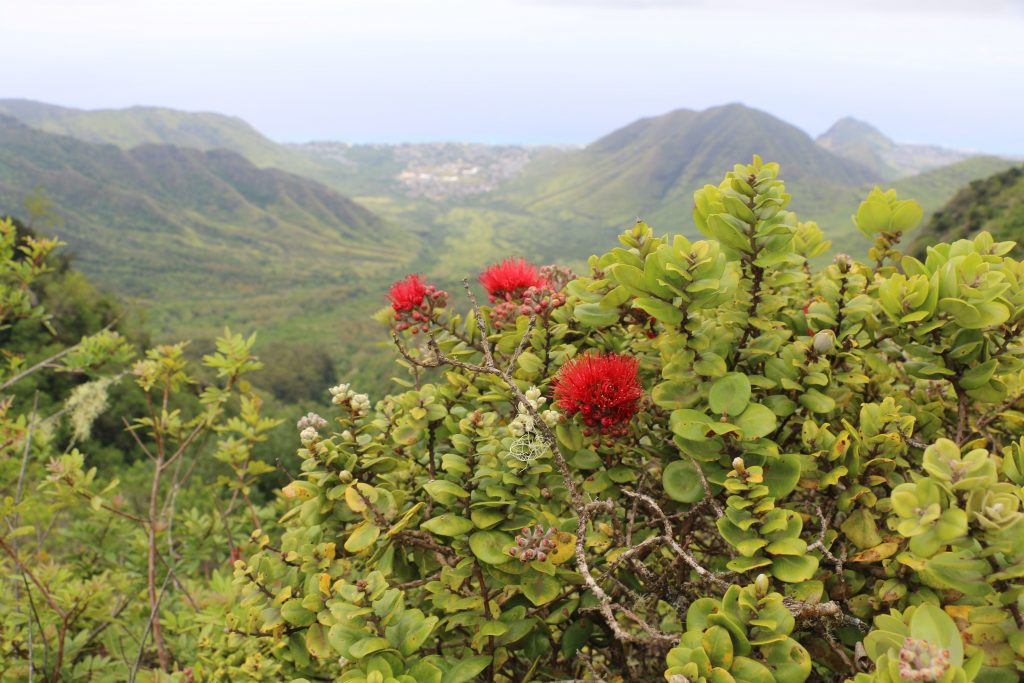01/13/20-RAPID ʻŌHIʻA DEATH BATTLE ESTIMATED TO NEED $4 MILLION ANNUALLY
Posted on Jan 13, 2020 in Forestry & Wildlife, Invasive Species, Main, Media, News Releases, sliderDEPARTMENT OF LAND AND NATURAL RESOURCES
News Release
| DAVID Y. IGE GOVERNOR |
SUZANNE D. CASE
CHAIRPERSON |
For Immediate News Release January 13, 2020
RAPID ʻŌHIʻA DEATH BATTLE ESTIMATED TO NEED $4 MILLION ANNUALLY
Strategic Response Plan Indicates Significant Progress with Much Work Ahead
To view video please click on photo or view at this link: https://vimeo.com/267029222
(Honolulu) – The 2020-2024 update to the original strategic response plan for the fight against Rapid ʻŌhiʻa Death notes many challenges ahead. Released today, the plan calls for additional funding of $4 million, each year, over the next five years to continue progress toward understanding and addressing the fungal disease that has seriously impacted Hawai‘i’s native forests.
The plan was developed in stages, beginning with a progress review and discussion at the Rapid ʻŌhiʻa Death Science Symposium in May 2019 on the UH-Hilo campus. A small team of editors worked on various components of the plan, which were then sent to twenty reviewers. The ROD Strategic Response Plan describes the need for continued emergency response efforts as well as for the long-term health of Hawai‘i’s forests.
The plan details understanding of the disease and the microscopic fungi that cause it. This understanding of biology, impact and movement in individual trees, and dispersal patterns and mechanisms has improved through significant investments in time, energy, and resources in research, that were prioritized in large part by the ROD Science team. The development and testing of science-driven management options continues to improve approaches to controlling the disease and protecting ʻōhiʻa forests.
Up until recently, the disease had only been detected on Hawai‘i Island, but in the past two years it has been found in limited areas on Kaua‘i, O‘ahu and Maui. A statewide ROD Working Group continues to lead response efforts and now each island has formed multi-agency working groups for information exchange, effective and efficient resource allocation, and swift response to new positive detections. The plan indicates that new outbreaks, “have elicited well organized, swift responses that apply containment, and, in some cases, eradication tactics developed using the best available science.
The Strategic Response Plan team reports, “The current status and distribution of the disease has also broadened our recognition that each island mush have adequate capacity for actions across the detection and response spectrum and that the needs for research, tools and management also differ.”
The team recognized that public engagement and outreach efforts have proven invaluable in developing broad awareness of the disease, its impacts to native forests and watersheds, and how to protect ʻōhiʻa. They conclude that all efforts can and must continue in order to protect, as fully as possible, Hawai‘i’s critically important, ʻōhiʻa-dominated native forests.
# # #
ROD Strategic Response Plan: https://gms.ctahr.hawaii.edu/gs/handler/getmedia.ashx?moid=66598&dt=3&g=12
Media Contact:
Dan Dennison
Senior Communications Manager
(808) 587-0396
[email protected]
